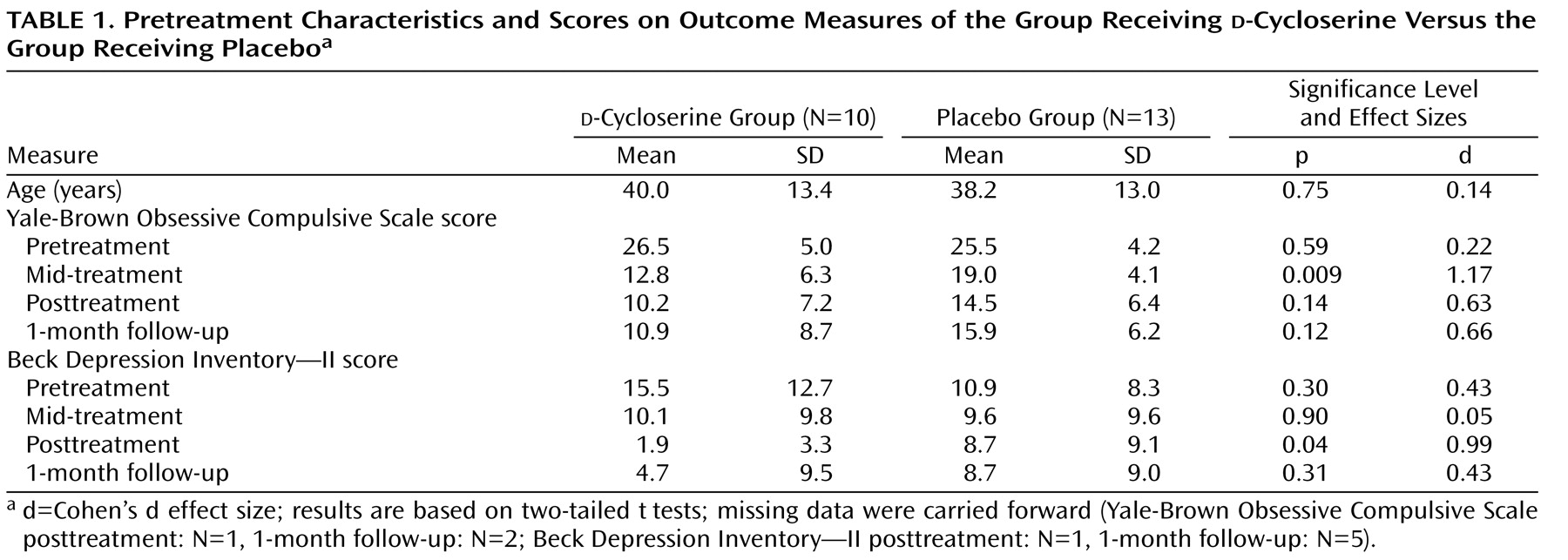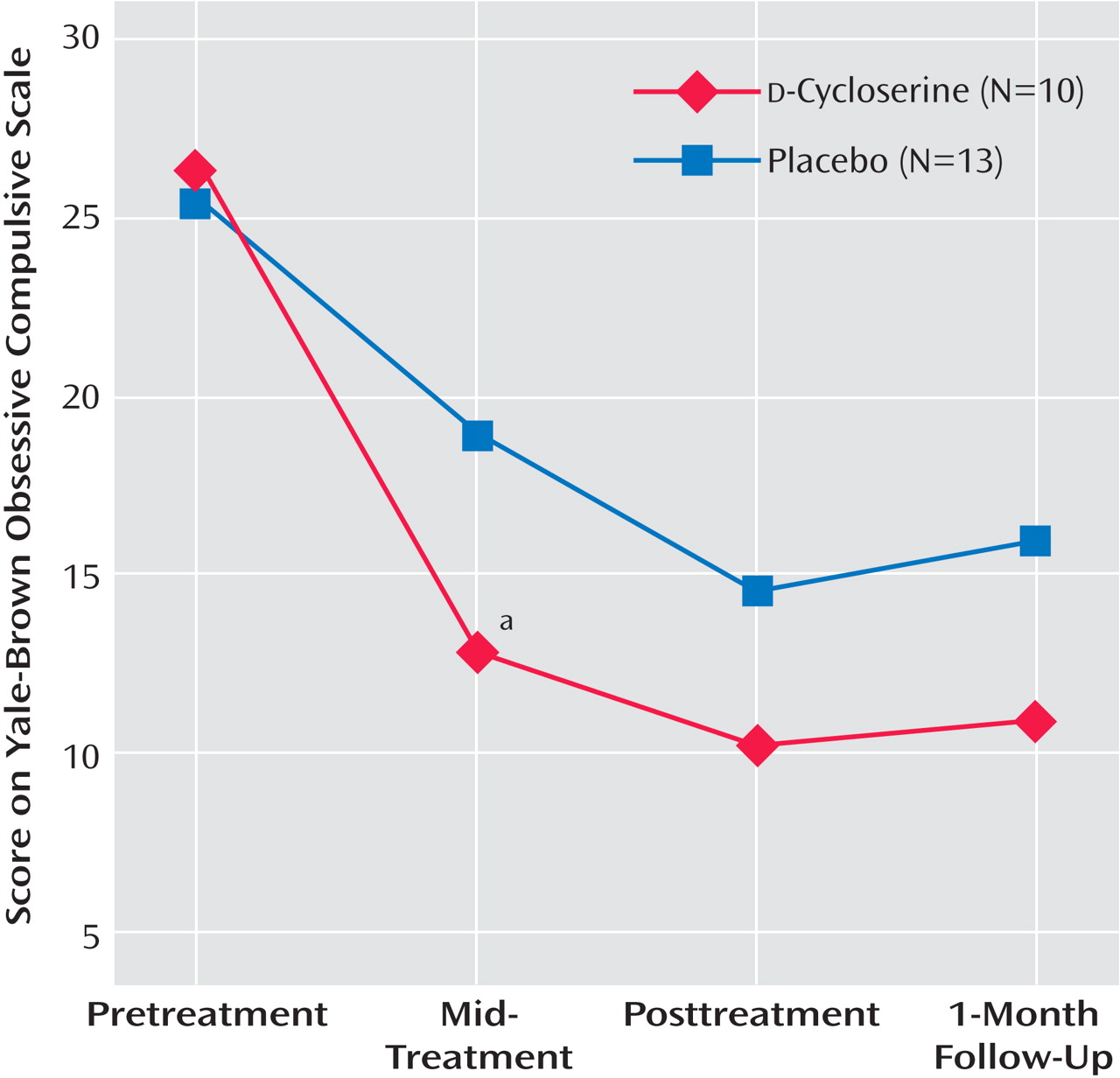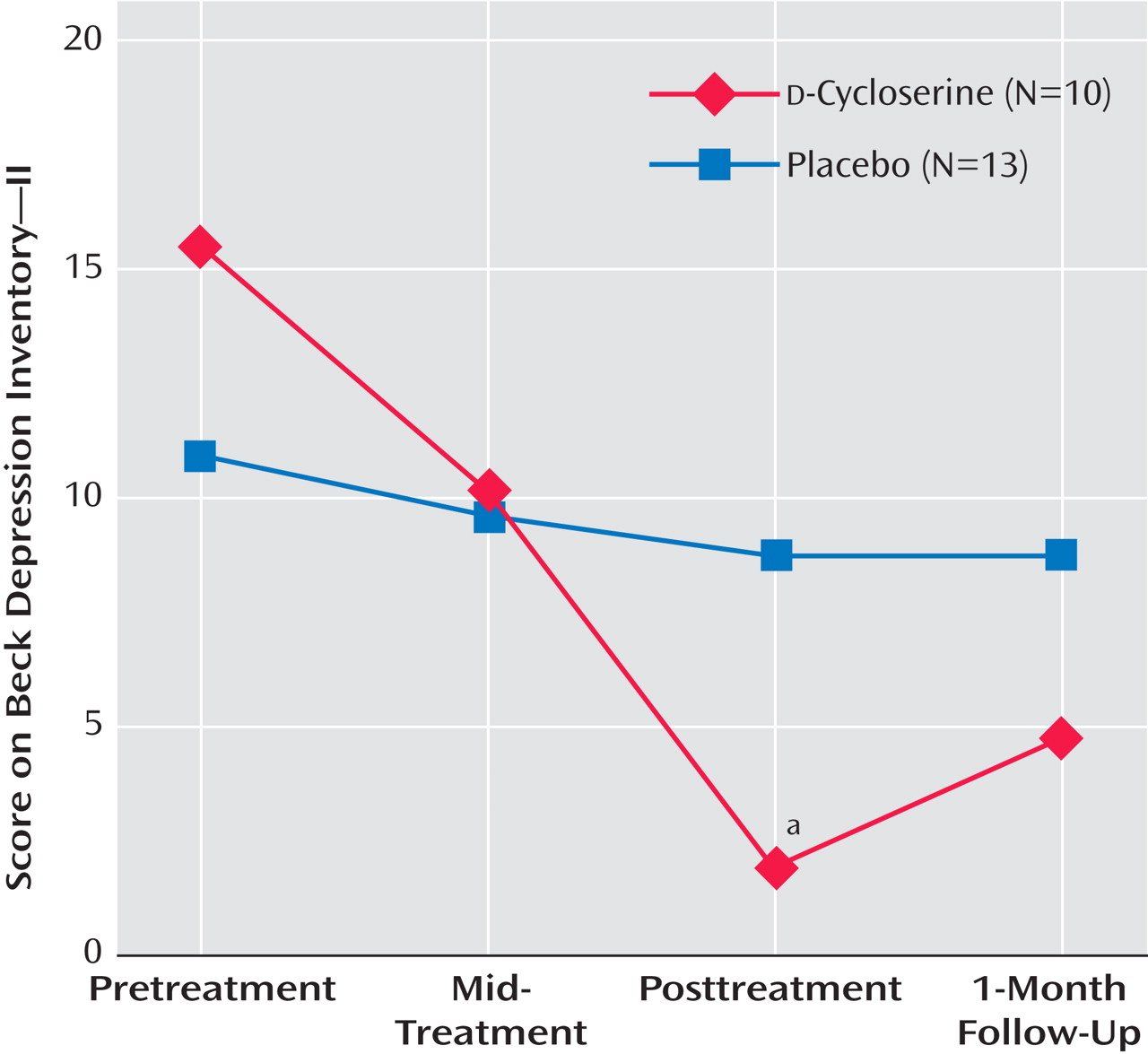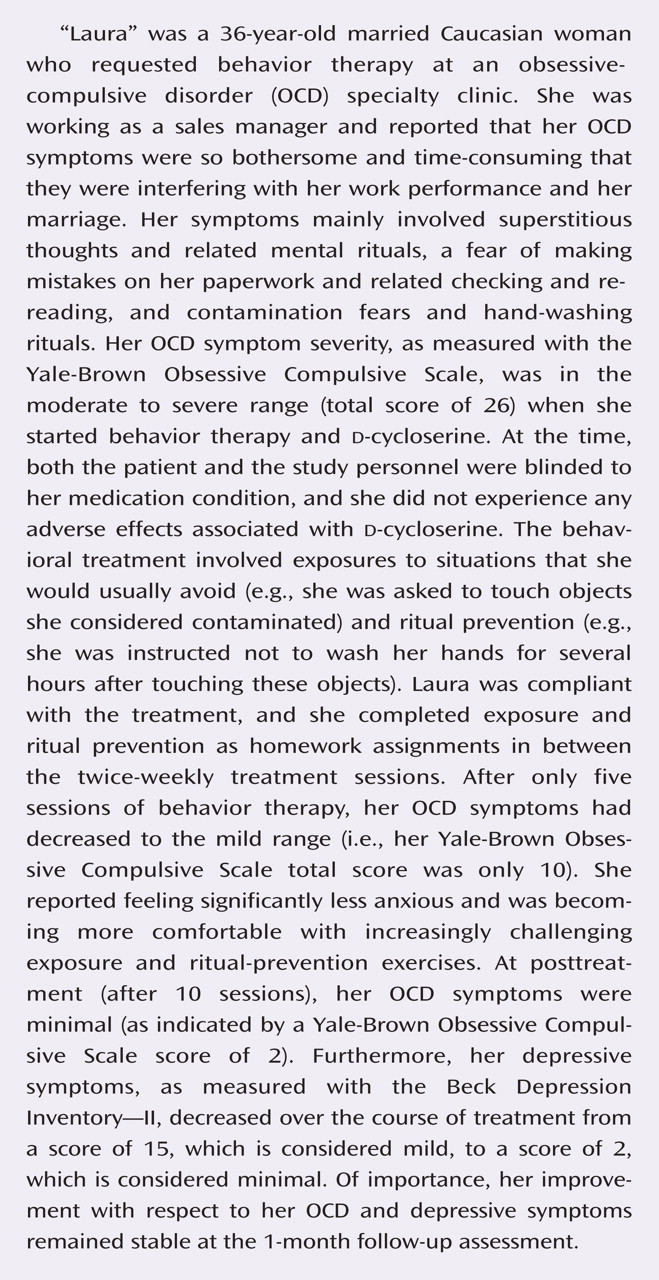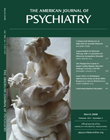In recent years, there has been increasing interest in the
N -methyl-
d -aspartic acid (NMDA) subtype of glutamate receptor and its role in extinction learning such as that purported to take place during exposure-based behavior therapy
(4) . Specifically, extinction of fear has been linked to NMDA receptor-dependent neural plasticity within the basolateral amygdala
(5 –
11) . The involvement of the NMDA receptor in fear extinction has led to an increasing body of research suggesting that NMDA receptor agonists, such as the partial agonist
d -cycloserine, may enhance extinction effects. Animal research indicates that rats receiving
d -cycloserine in addition to extinction training show significantly less posttraining conditioned startle than do rats receiving extinction alone. Rats receiving
d -cycloserine who did not also receive extinction training did not benefit, suggesting that the findings were due not to any anxiety-attenuating properties of
d -cycloserine itself but rather to the facilitative effect of
d -cycloserine on the neural mechanisms of extinction
(12) .
In the first test of
d -cycloserine augmentation of exposure therapy in anxiety-disordered humans, Ressler et al.
(13) randomly assigned subjects with a fear of heights to receive placebo;
d -cycloserine, 50 mg; or
d -cycloserine, 500 mg; 1 hour before two sessions of exposure-based virtual-reality behavior therapy. The patients receiving
d -cycloserine appeared to benefit more from exposure therapy than did the patients receiving placebo. At posttreatment, approximately 60% of the participants who received exposure plus
d -cycloserine, versus approximately 20% of those receiving exposure plus placebo, rated themselves “much improved” or “very much improved.” These differences were maintained through a 3-month follow-up assessment. More recently, Hofmann and colleagues
(14) extended these findings to patients with social anxiety disorder. Participants with significant public speaking anxiety were randomly assigned to receive
d -cycloserine, 50 mg, or placebo 1 hour before four public speaking exposure sessions. At posttreatment, the participants receiving exposure plus
d -cycloserine reported significantly less social anxiety compared to patients receiving exposure plus placebo. This difference was even greater at the 1-month follow-up, and controlled effect sizes were in the medium to large range.
To date, to our knowledge, two studies have investigated augmentation of behavior therapy with
d -cycloserine in individuals with OCD. Storch and colleagues
(15) randomly assigned 24 OCD patients to 12 weekly 75–90-minute sessions of behavior therapy plus 250 mg
d -cycloserine versus behavior therapy plus placebo. The
d -cycloserine or placebo was given 4 hours before the treatment sessions. They did not find any group differences with respect to OCD symptom decrease, as measured by the Yale-Brown Obsessive Compulsive Scale. A recent study by Kushner and colleagues
(16) also tested whether
d -cycloserine augments the efficacy of behavior therapy in patients with OCD. Twenty-five patients received either
d -cycloserine, 125 mg, or placebo 2 hours before each twice-weekly session of exposure-based behavior therapy. The patients received up to 10 sessions of behavior therapy (treatment was terminated earlier if treatment goals were reached sooner). The results revealed no significant difference between the two groups at posttreatment or 3-month follow-up in OCD severity on the Yale-Brown Obsessive Compulsive Scale
(17) . However, after four sessions, the patients in the
d -cycloserine group reported significantly greater decreases in subjective units of distress associated with certain obsession-related stimuli compared to the placebo group. Unfortunately, this study did not include the Yale-Brown Obsessive Compulsive Scale or other comprehensive assessment midway through treatment.
Thus, so far, the research on
d -cycloserine augmentation of behavior therapy in OCD has led to inconsistent results. The aim of the present study was to conduct a double-blind, placebo-controlled trial of
d -cycloserine augmentation of 10 hours of twice-weekly behavior therapy in individuals with OCD. Similar to the
d -cycloserine-augmented trials for height phobia
(13) and social anxiety
(14), we also chose a briefer treatment duration than what would usually be administered for a non-
d -cycloserine-augmented OCD treatment trial
(1) . It was hypothesized that patients receiving
d -cycloserine would show significantly greater improvement in OCD symptoms compared to patients receiving placebo and that the advantage of
d -cycloserine would remain after treatment discontinuation. It was further predicted that
d -cycloserine would result in a more rapid response to treatment, as evidenced by a mid-treatment assessment.
Discussion
The results of this double-blind, randomized, controlled trial indicate that patients in the d -cycloserine group had significantly lower OCD symptom severity scores than did patients in the placebo group at mid-treatment and that the effect size was large. At posttreatment and 1 month after the end of treatment, group differences in OCD severity no longer reached statistical significance, but effect sizes were still in the moderate range. d -Cycloserine-augmented behavior therapy was superior to placebo-augmented behavior therapy for depressive symptoms at posttreatment. Thus, our study showed that d -cycloserine augmentation may accelerate and potentiate behavior therapy for OCD.
Our positive findings differ somewhat from those of Storch et al.
(15), who found no significant benefit of
d -cycloserine augmentation of behavior therapy for OCD at any point over the course of the treatment. It is likely that ceiling effects may have contributed to the results obtained in the study by Storch et al., which yielded an usually large reduction in score on the Yale-Brown Obsessive Compulsive Scale of over 70% in the behavior therapy plus placebo group (versus a 44% reduction in the present study). It is also possible that patient or therapist differences between the two studies contributed to a greater overall treatment effect in the study by Storch et al., thus obscuring any effect of
d -cycloserine.
However, several methodological differences might also account for this discrepancy. For example, it is possible that the high doses resulted in diminished learning effects
(22) . The present study used a dose of 100 mg, whereas Storch et al.
(15) used a dose of 250 mg to augment behavior therapy for OCD. Previous studies investigating
d -cycloserine for behavior therapy augmentation of anxiety disorders in humans have used a dose of 50 mg
(13,
14), and Kushner and colleagues
(16) used a dose of 125 mg. In the earliest
d -cycloserine-augmented behavior therapy trial in humans, Ressler and colleagues
(13) did not find evidence of a difference between a dose of 50 mg and a dose of 500 mg; however, other research suggests that there may be a narrow therapeutic range of
d -cycloserine when used to enhance learning. For example, animal models suggest that the NMDA receptor can become desensitized after prolonged exposure to
d -cycloserine
(22) . Thus, it is possible that a high dose of
d -cycloserine can have an attenuated effect on fear extinction compared to a lower dose, such as that used in the present study.
Another key variable appears to be the timing of
d -cycloserine administration. Comparable to the promising study by Hofmann et al. on social anxiety
(14), in our OCD study, the medication was given 1 hour before each session. The OCD patients of Kushner et al.
(16) took the medication 2 hours before each session, and in their study, the significant group differences occurred at session four. In contrast, Storch et al.
(15) administered
d -cycloserine 4 hours before each session of behavior therapy for OCD, and the groups did not differ significantly at any point during or after treatment. Thus,
d -cycloserine might lose efficacy if given too early before extinction training; indeed, animal research suggests that
d -cycloserine is most effective when administered immediately before or even immediately after extinction training
(23) .
In addition to dosing and timing of medication administration, another important factor might be the number of behavior therapy sessions and the related frequency of
d -cycloserine administration. Although the number of behavior therapy sessions was comparable across the two studies (10 sessions in the present study, 12 sessions in the study by Storch et al.
[15] ), the present study used twice-weekly sessions, whereas Storch et al. provided weekly sessions. Therefore, the total duration of behavior therapy with concurrent
d -cycloserine administration was 5 weeks in the present study versus 12 weeks in the study by Storch et al. The longer duration of the study by Storch et al. translates to a greater amount of between-session homework assignments that were not augmented with
d -cycloserine; and this greater frequency of non-
d -cycloserine-paired homework exposures may have obscured the effects of
d -cycloserine.
It is also possible that the extinction-augmenting effects of
d -cycloserine are time limited. Indeed, close examination of the results of Storch et al
(15) suggests that there was a (nonsignificant) tendency favoring
d -cycloserine in that study at week 6. Kushner et al.
(16) found group differences at session 4, and in the current study, we found a large effect after five behavior therapy sessions. At posttreatment, none of the studies showed significant
d -cycloserine versus placebo group differences. Thus, an inspection of all studies on the effects of
d -cycloserine augmentation of behavior therapy for OCD indicates that effects of
d -cycloserine for OCD are most powerful early in treatment, and over time, differences between
d -cycloserine and placebo augmentation seem to decrease. Longer-term use of
d -cycloserine might parallel the strategy used for treating schizophrenia and Alzheimer’s disease, which has yielded generally disappointing results
(24 –
28) . Studies of isolated versus long-term dosing of
d -cycloserine in animals revealed positive effects on spatial learning only for isolated dosing
(29), and preexposure to
d -cycloserine eliminates the enhancing effects of
d -cycloserine on the extinction of conditioned freezing
(30) . Thus,
d -cycloserine administration over a shorter time period may be critical for augmenting exposure-based treatment.
The present study offers stronger evidence for the treatment-enhancing effects of
d -cycloserine than does the study by Kushner et al.
(16) . Indeed, in our
d -cycloserine group, the patients’ OCD symptom severity scores were in the severe range before treatment, and after only five sessions, the scores had dropped to the mild range. Kushner et al. included only subjective fear ratings at mid-treatment, whereas the present study employed a comprehensive mid-treatment assessment using the gold standard rating scale in OCD (the Yale-Brown Obsessive Compulsive Scale). The rapid improvement within only five sessions, assessed with a reliable, valid, clinician-administered OCD symptom severity measure, is an important difference from the study by Kushner et al. Our research suggests that the acceleration of treatment response is a major advantage of
d -cycloserine augmentation of behavior therapy. Future research should include more assessment points and process-focused measures (e.g., on OCD-related dysfunctional beliefs) to precisely determine when group differences occur and how treatment augmentation might have accelerated treatment response.
It is also informative to examine how our findings compare to the findings of previous studies of non-
d -cycloserine-augmented behavior therapy for OCD. In one of the largest and best trials of behavior therapy to date
(1), patients received an intensive behavior therapy treatment consisting of two information sessions, 30 hours of behavior therapy (15 2-hour sessions), and two relapse-prevention sessions. Patients in that study showed a 55% decrease in OCD symptom severity on the Yale-Brown Obsessive Compulsive Scale. In the present study, using 1-hour behavior therapy sessions held twice a week, the patients receiving
d -cycloserine plus behavior therapy showed a 52% Yale-Brown Obsessive Compulsive Scale score decrease at mid-treatment (5 hours of exposure) and a 62% decrease at posttreatment (10 hours of exposure), underscoring
d -cycloserine’s significant potential as an augmentation strategy for behavior therapy.
The present study has important clinical implications for patients who often experience significant anxiety over the course of prolonged exposure treatments. Currently, the refusal and dropout rates for behavioral treatments in OCD tend to be high (e.g., reference
1 ). However, patients might be more likely to initiate, and less likely to discontinue, a treatment that reduces anxiety faster and is less time intensive. Thus, future large-scale studies will need to investigate whether
d -cycloserine-augmented behavior therapy will be more acceptable to patients than conventional behavior therapy. Future studies will also need to investigate whether more powerful and efficient
d -cycloserine-augmented treatments have lower dropout rates.
d -cycloserine is an inexpensive augmentation strategy, and faster behavioral treatments reduce the cost of care, which is an important consideration in managed health care environments.
Of interest, in the current study, we found that
d -cycloserine augmentation of behavior therapy for OCD also had positive effects on depression. This is of note given the evidence suggesting that acute high doses of
d -cycloserine might have an antidepressant effect in their own right
(31) . However, our findings suggest that improvements in depression might have been secondary to the initial improvement in OCD symptoms, as has been found previously
(32) . It would be useful for future research to investigate whether
d -cycloserine accelerates or increases the modification of dysfunctional beliefs, which might point to a mechanism of change of relevance to both OCD and depression.
In conclusion, although treatment strategies for OCD have improved, overall, the success rate of treatment is still rather low. Previous research has simply combined behavior therapy with medications that are designed to reduce obsessions, compulsions, and avoidance, and this research has yielded limited results
(1) .
The current study yielded promising results when behavior therapy for OCD was combined with
d -cycloserine.
d -cycloserine has been used and evaluated frequently. It was originally approved by the Food and Drug Administration for the treatment of tuberculosis. More recently,
d -cycloserine has been used to augment exposure-based behavior therapy for several anxiety disorders. The present study, as well as others, has shown that short-term dosing seems to be associated with minimal adverse effects, and the low dose we used was well tolerated. Thus, clinicians might be eager to use
d -cycloserine for behavior therapy augmentation in OCD. However, the opinion of the present authors is that it is premature to recommend this unapproved drug for routine clinical use at this early stage of testing. Although several small studies have now indicated that
d -cycloserine might show promise as an augmentor of exposure-based psychotherapy, as with all pilot studies, these findings first need to be confirmed in larger studies.
